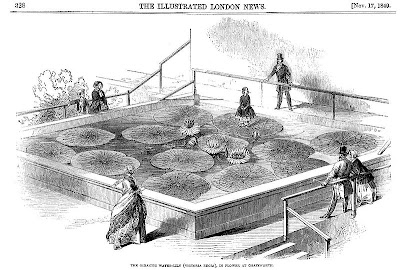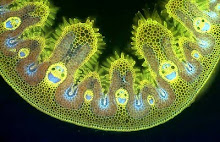I've only ever grown this wonderful plant once, raising it from seed and coaxing it to produce this single cluster of fabulous flowers before making the mistake of giving it too much water. It's not called a desert pea for nothing - wet roots and humid conditions are death to it. Trouble is, if you keep it hot and dry (as I did with the two other seedlings I raised) it succumbs to attacks of red spider mite very easily in greenhouses in England. So, when it comes to watering it, you're damned if you do and you're damned if you don't. The only solution is to move to South Australia, where it's the state flower and is perfectly at home. I gather that this plant also now goes under the name of Swainsona formosa.
Wednesday, January 27, 2010
Thursday, January 21, 2010
Parachute Plant Ceropegia sandersonii
I’ve only ever grown the the parachute plant Ceropegia sandersonii once and then not very successfully – just when it was covered in these remarkable flowers I let the soil get too cold and wet and it rotted off, and I haven’t been able to get my hands on another plant since. It comes from South Africa and belongs to a genus of plants that trap insects inside the flower until they effect pollination. Flies carrying pollen crawl in through one of the five openings at the top, crawl down the funnel-shaped tube where downward-pointing hairs prevent them from retreating and are trapped in a chamber at the bottom until they pollinate the flower. Then the hairs wither and the flies escape, carrying more pollen for another cross-pollination. There are numerous Ceropegia species, each pollinated by different insects and some very small. You can see the internal structure of the flower of another species, Ceropegia woodii, also known as the Chain of Hearts, here.
Labels:
Ceropegia sandersonii,
Parachute plant
Tuesday, January 12, 2010
Giant Amazonian Water lily, Victoria amazonica
The giant Amazonian water lily Victoria amazonica is an expensive plant to cultivate, requiring a very large glasshouse with a deep, heated pool..... deeper water producing larger leaves. It was originally discovered in Guiana by the Victorian explorer Sir Robert Schomburgk in 1837, although a German called Poeppig had earlier seen and described it while rafting down the Amazon. This led to a good deal of confusion over naming of this aquatic giant. According to the arcane but rigid rules of botanical nomenclature it should correctly be called Victoria amazonica but throughout the reign of Queen Victoria it was known as Victoria regia (literally Queen Victoria) and only assumed its botanically correct name after the old Queen died and it was safe to change the labels. Once the first seeds were brought back to England there was a race amongst the landed gentry to be the first to cultivate the plant and present a flower to the Queen, victory going to the Duke of Devonshire whose head gardener at Chatsworth, Joseph Paxton, built a suitably large glasshouse to accommodate the monster plant ... with no expense spared.
One of the most remarkable features of this plant is that it can be grown as an annual, with seeds being germinated in late winter and then transplanted into a heated pool in late spring. By mid-summer the gigantic leaves are well developed and the spectacular flowers form. These only last for two days. On the first evening they open overnight (attracting beetle pollinators in the wild) then close, trapping their pollinators within (you can watch a movie of this here). Once pollinated they flush pink, open to release the captive beetles then sink below the water to develop a seed capsule. Harvesting the seed capsules in a botanic garden is hazardous - you need a wetsuit to protect you from the plant's vicious underwater spines on the stems and underside of the leaf.
The undersides of the giant leaves inspired one of the most famous examples of Victorian architecture. Noting the wonderful structural bracing formed by the massive leaf veins on the underside of the leaves, Joseph Paxton sketched the competition-winning design for the building that housed the 1851 Great Exhibition in Hyde Park – compare the photo of the veins above with the contemporary illustration of the end gable of the building here. The adventurous design, at the cutting edge of engineering in its day and constructed with cast iron framing and the largest panes of plate glass then manufactured, became known as the Crystal Palace and was a wonder of the age, earning Paxton a knighthood.
The Gigantic Waterlily (Victoria Regia), In Flower At Chatsworth
Victoria amazonica has been a crowd-puller in botanic gardens ever since the day that Paxton first flowered the plant. The contemporary illustration above, from the Illustrated London News, shows his daughter Annie standing on one of the giant lily pads - a stunt that isn't recommended as although the spiny veins below are extremely tough the leaf itself is relatively delicate - you can poke your finger through it with ease and if a child's leg slipped through between the veins it would be badly lacerated. There are actually two species of Victoria and the photographs above are of the more compact V. cruziana from Paraguay, seen here growing in Durham University Botanic Garden in 2009; this species has purple rather than red leaf undersides. If you are in Durham, it's well worth visiting the plant....
Victoria Regia : or, Illustrations of the Royal water-lily, in a series of figures chiefly made from specimens flowering at Syon and at Kew by Walter Fitch; with descriptions by Sir W.J. Hooker .
http://en.wikipedia.org/wiki/File:Victoria_Regia._(Analyses)_(1851).jpeg
Sunday, January 10, 2010
Bitter Gourd, Momordica charantia
Bitter Gourd Momordica charantia has to be one of the most memorable plants for a conservatory that I've grown in recent years. Once germinated the seedlings grow very quickly and need to be trained up a support (a wig-wam of canes works very well), which they tie themselves to very efficiently with their tendrils. Then they produce large numbers of yellow flowers. These are nothing special to look at - rather like cucumber flowers - but like many members of the cucumber family the plants are dioecious, producing separate male and female flowers on the same plant, so you have to pollinate them by hand to be sure of good fruit set on the female flowers..... but it's worth the effort. They quickly produce what look like small, warty cucumbers that are 15-20 cm. long which ripen to a vivid shade of yellow then suddenly split open at the tip to reveal seeds covered with a sticky scarlet aril (an extra seed coat). The fruit is edible if cooked (but they're not called bitter gourds for nothing!) and they have a long history of use in Ayurvedic medicine . For that reason the plant is widely grown in India, although no one seems sure exactly where it originally came from. There is also some recent reputable research that suggests that the plant's chemical constituents may be of value in the treatment of diabetes. It's widely grown throughout the tropics, from Africa to the West Indies.
Labels:
Bitter Gourd,
Cucurbitaceae,
Momordica charantia
Thursday, January 7, 2010
Chinese Witch Hazel,Hamamelis mollis
The soothing, mildly antiseptic properties of the distillatie from witch hazel bark have been known for generations and it’s still used in medicine that you can buy in the chemist shop, including a well-known brand of eye lotion that soothes tired and sore eyes. Hamamelis mollis comes from Central and Eastern China but the selected forms of the plant that you buy in the local garden centre are usually grafted onto the vigorous North American H. virginiana (see illustration below), rather than grown on their own roots. H.virginiana is the usual medicinal source of witch hazel distillate. The fragrant flowers of Chinese witch hazel, produced in late winter, are attractive and so are its leaves when they turn golden-yellow in autumn. There are faster-growing hybrid forms with orange-red flowers, but their autumn foliage is comparatively dull. The common name is sometimes spelled wych hazel, which is apparently the original spelling, which has since been corrupted to witch hazel.
Illustration of H.virginiana from Franz Eugen Köhler, in Köhler's Medizinal-Pflanzen published in 1887, via Wikipedia Commons (http://en.wikipedia.org/wiki/File:Koeh-070.jpg)
Labels:
Hamamelidaceae,
Hamamelis mollis,
Witch Hazel
Tuesday, January 5, 2010
Wintersweet Chimonanthus praecox
Any botanic garden worthy of the name needs to have interesting plants in flower in every season - so here’s the beautifully fragrant wintersweet Chimonathus praecox, which began flowering in my Durham garden at Christmas, despite the freezing conditions. The flowers are about 1cm. in diameter and are carried on bare twigs. A small bunch cut and brought indoors will scent a room. This is a very hardy shrub that comes from mountainous regions of China so it’s thoroughly hardy, but as an extra precaution I’ve planted it against a south-facing wall, which has kept the worst of the ice and snow away and encouraged it to flower early. That hasn’t protected it from desperately hungry blue tits, though, that seem to like to peck at its flower buds.
I don’t know when this plant blooms in its native China or what pollinates its flowers, but what is certain is that there are no insects to pollinate it when it flowers here in winter. That’s not a problem though, because after the flowers have been open for a couple of days those five white stamens that you can see in the upper photo close over the stigma of the flower, self-pollinating it. The pictures above and below are of the same flower, but taken 24 hours apart.

Recent research in China has shown that the seeds of this shrub have antifungal and antibacterial properties, which may be of potential economic value.
Labels:
Calycanthaceae,
Chimonanthus praecox,
Wintersweet
Sunday, January 3, 2010
Florist's Anemone, Anemone coronaria
I’ve never had much luck cultivating Anemone coronaria in my Durham garden but perhaps that not such a surprise, because it hails from the Eastern Mediterranean. The plant dies back to a small woody corm every year and I suspect that these rot rather easily if the soil is too wet. It makes a lovely cut flower but the best way to appreciate it is in its native habitat, flowering in spring around fields in the Middle East . It's a particularly popular wild flower in Israel. The plant seems to be unpalatable to most grazing animals but recently roe deer have been reintroduced into Israel, after being extinct there since the beginning of the 20th. century, and have shown a predilection for nibbling off the flower buds before they can open, which sounds like a potential conservation conflict. Anemone was the daughter of the winds in Greek mythology and the Roman naturalist Pliny the Elder believed that spring winds were needed to bring this plant into flower.
I photographed these anemones growing wild on a rocky hillside near Aleppo in Syria about twenty years ago. There were drifts of them, all over the hillside - an unforgettable sight.
Labels:
Anemone coronaria,
Florist's anemone,
Ranunculaceae
Subscribe to:
Comments (Atom)







_(1851).jpg)



















